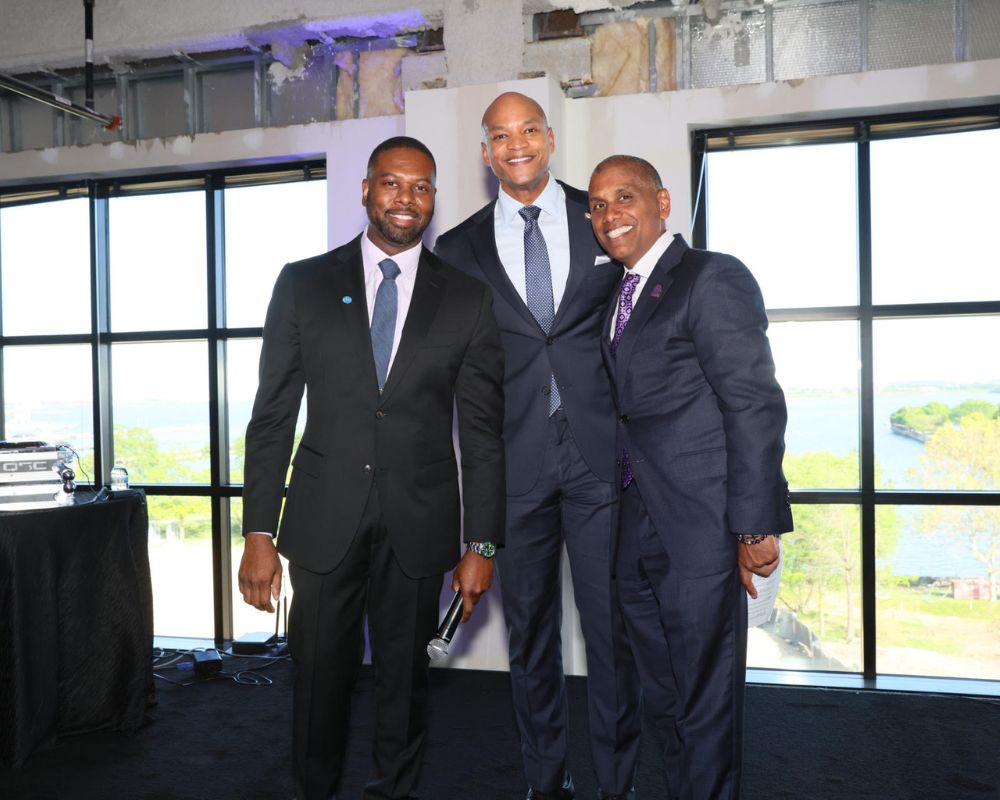A new development has emerged in South Baltimore, the latest iteration of a multi-year transformation project, on Thursday played host to various business, technology, education, real estate and civic communities that gathered to celebrate the Baltimore region’s “transformative change.”
Set against the picturesque backdrop of the Baltimore Peninsula, the Greater Baltimore Committee (GBC), a prominent membership-based organization and self-proclaimed voice for the regional private sector, invited these stakeholders to its recent annual meeting at 2455 House Street. This event marked not only the gathering of esteemed members but also served as the public introduction of GBC’s new leadership.
Days before the gathering, in a recent sizzle reel previewing the meeting, GBC’s newly appointed CEO Mark Anthony Thomas proudly proclaimed that “Baltimore possesses all the essential elements to compete on a global stage.” This statement alluded to GBC’s multi-year agenda, spanning from 2024 to 2026, in which Thomas emphasized that Baltimore’s combined business and civic community resources are crucial to the city’s potential.
Arriving attendees were greeted with nametags that featured printed names, adorned with special ribbons to signify sponsors and dignitaries like Gov. Wes Moore and Mayor Brandon Scott. The gathering attracted a diverse range of distinguished business and civic leaders, representing both renowned and lesser-known organizations, educational institutions and civic entities in and around Baltimore. Attendees used ample opportunities for mingling and enjoyment throughout the event. A cyclist circulated the venue, graciously offering glasses of wine to guests and adding a touch of novelty to the experience. A photo booth, adorned with a hand-painted, Baltimore-centric mural created by local artist Roe Vision, provided a backdrop for capturing memorable moments. Additionally, attendees were treated to complimentary tote bags — also specially designed by the young artist, who is not only Black but also a woman and thus reflected the diversity and creative talent within the community.

Ahead of the event, Thomas described a need for all of the area’s business and civic sector constituents to participate in Baltimore’s growth.
“As an organization, we’ve been incredibly busy over the last few months growing our team, introducing a new board chair, forming new partnerships and bringing a renewed vision for the GBC to life,” said Thomas in a press release provided to Technical.ly. “To deliver large-scale transformative change that advances a thriving Greater Baltimore Region, we will need the buy-in, support and participation of the business community from across all sectors, industries and corners of the map, along with our community leaders and elected officials. I’m looking forward to working with everyone to keep the momentum going.”
To that end, the GBC’s 12-step plan focuses on three key areas: economic opportunity, transportation/infrastructure and collective impact. GBC’s strategic initiatives aim to enhance the region’s brand, attract strategic investments, advance transit infrastructure, combat gun violence, support neighborhood redevelopment and foster entrepreneurship.
A key component of GBC’s approach is its partnership with advisory firm TIP Strategies, Inc., which will play a vital role in developing a larger, decade-long economic opportunity strategy. This collaborative effort will support the ambitious goals outlined in the 12-step plan and pave the way for sustained positive change in Baltimore.
The 12 steps are as follows:
- Step 1: Develop a strategy for driving inclusive economic growth over the next 10 years.
- Step 2: Amplifying the region’s assets, history and progress to effectively brand Baltimore.
- Step 3: Harnessing the collective impact of our local economic community and development leaders to ensure successful strategic investments in our community.
- Step 4: Pursuing game-changing opportunities for federal and other strategic investments, highlighting our unique ecosystem for education and technology.
- Step 5: Building partnerships with the public sector to drive local, domestic, and foreign direct investment and business expansion in the region.
- Step 6: Creating a robust foundation for opportunity by embracing and celebrating the ultimate transit future.
- Step 7: Catalyzing the region’s larger infrastructure for long-term sustainability.
- Step 8: Tackling gun violence through multifaceted approaches.
- Step 9: Supporting local law enforcement retention and hiring.
- Step 10: Supporting neighborhood redevelopment by tackling the city’s vacant housing issue.
- Step 11: Driving local hiring and procurement.
- Step 12: Improving business friendliness to stimulate new investments in neighborhoods and new business sites.







